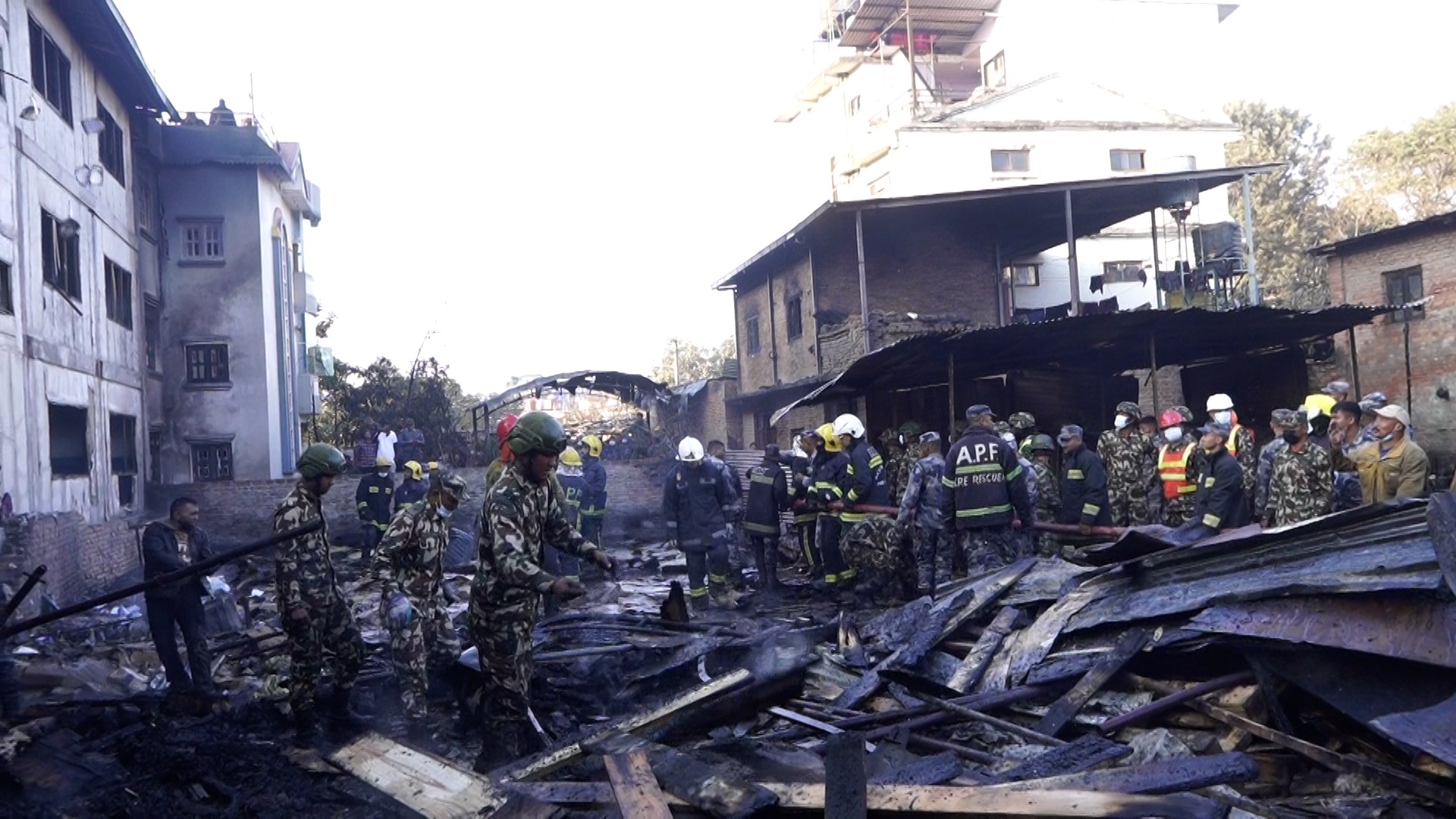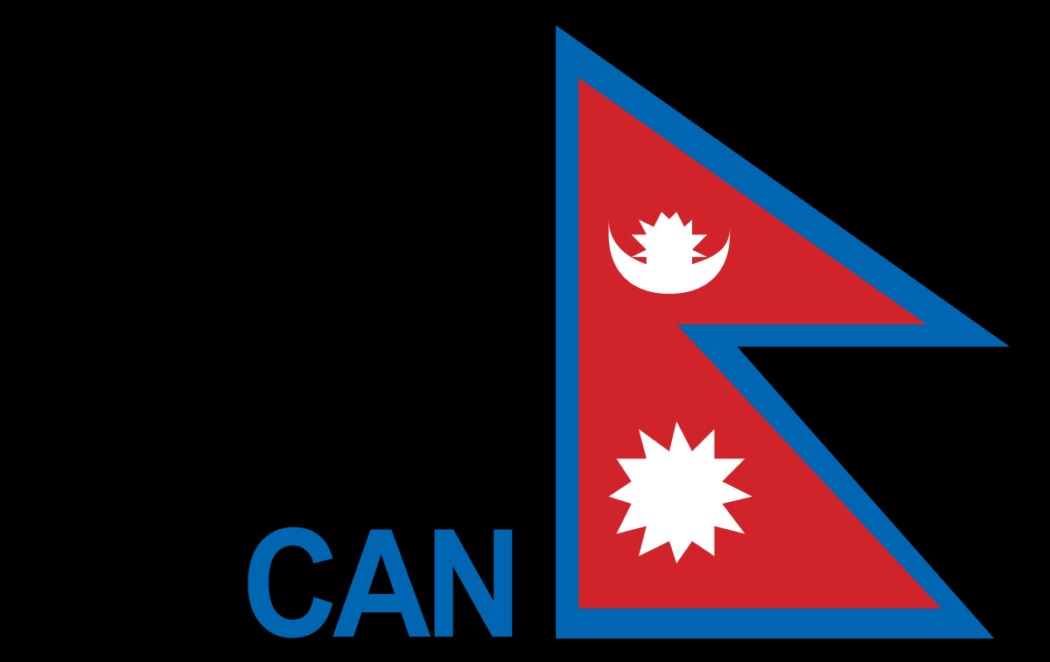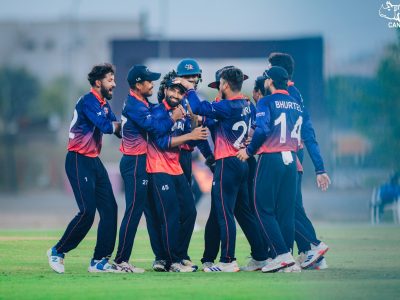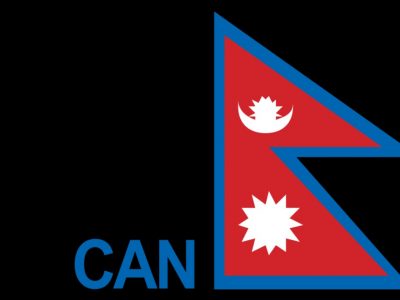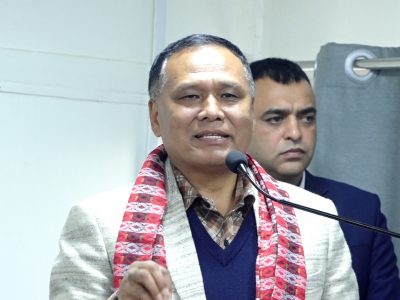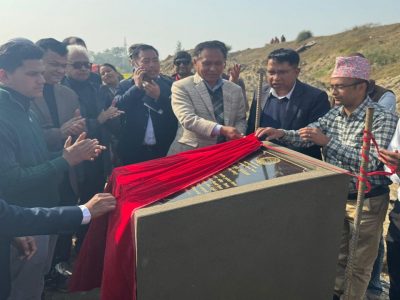Journey to Eastern Nepal, Context: Kiwanis Sixth District Convention

On the 25th and 26th of Shrawan, 2081 B.S., the 6th District Convention of Kiwanis Nepal was scheduled to be held in Itahari, Sunsari. Following mutual discussions and decisions, the members of Kiwanis Club Lord Buddha planned to travel to Eastern Nepal. On Wednesday morning at 5 a.m., the jeep arrived at my residence in Tulsipur. When I called my fellow members, I was informed that everyone was ready. With great enthusiasm, I, Bamshi Kumar Sharma, set off on the journey to Eastern Nepal from Tulsipur with Narayani Rajoure, the Elect President of Kiwanis Club of Lord Buddha, and her son, Nabin Adhikari. Other members had already joined along the way, eagerly awaiting our arrival.
At Manikapur 18 in Tulsipur, Rakesh Basnet joined us, and from Ghorahi, we were accompanied by Sushila Shah, bringing the total to six of us, including the driver. We embarked on our journey to Eastern Nepal, eager to witness the unforgettable scenic beauty and visit the religious sites in the area. We also planned to explore and study the commercial and industrial cities of Nepal before attending the club’s convention. With our bags packed, we boarded the vehicle and began our journey from Tulsipur Bazaar, taking in the warm, steamy air of the Tarai and the breathtaking views. Around 8 a.m., we stopped at the hills of Musot in Dang to take some photos, while some of the group recorded videos. Though brief, it was a moment to enjoy the lush greenery and appreciate the panoramic view of the Dang Valley.
Nabin Adhikari suggested that we stop for some tea and snacks, so we decided to take a break in Bhaluwang, the capital of Lumbini Province. By chance, we met Bhim Marasini, a leader affiliated with the Nepali Congress Trade Union, who was also present. He graciously invited us to join him for tea, and together, we enjoyed a meal of traditional jeri-puri and vegetables. Bhim Marasini turned out to be the President of the Indrani Club, which has been actively engaged in various social works in the region. He also showed us the club’s three-storey building, which was a testament to their contributions.
The driver, Ramu Chaudhary, added to the enjoyment of our journey by playing folk songs in the vehicle, making our trip even more delightful. Our fellow traveler, Sushila Shah, also joined in the fun by singing patriotic songs in her melodious voice. We stopped in Shivanagar, where we shot another video, and later, a traffic officer we met in Chanauta suggested we take the road through Krishnanagar Bahadurganj, as it was in better condition. Following his advice, we agreed to visit Krishnanagar Bazaar in Kapilvastu.
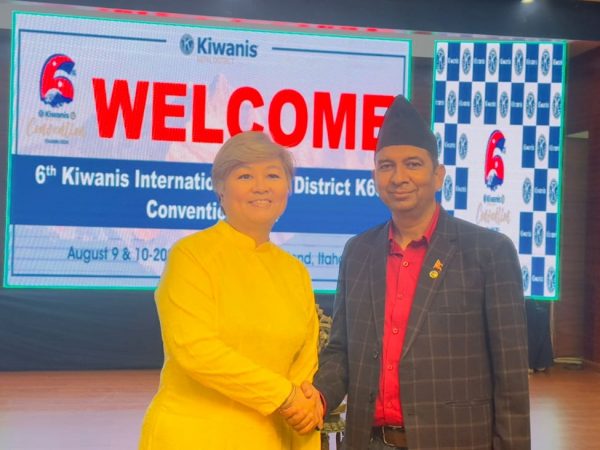
In Krishnanagar, we met Abhishek Pratap Shah, a leader of the Nepali Congress and a former Member of Parliament. He invited us for tea, and as we sat together sipping tea, we learned about the history of Krishnanagar Bazaar and the significance of this historic trade gateway of Nepal. From there, we continued our journey through the sacred land of Kapilmuni, passing through the district headquarters of Taulihawa and finally arriving at Kapilvastu, the birthplace of Lord Gautam Buddha.
This route was new to us, but we found it to be very scenic. Taulihawa, during the Rana period, was a major administrative center in the Terai region. The Ranas had established it as a center for handling legal cases, collecting taxes, and overseeing administration. The chief official who resided there was known as Badahakim. As we passed through Taulihawa Bazaar, we reached Kapilvastu, the birthplace of Lord Gautam Buddha, at around 11:30 a.m. Lumbini, the birthplace of Lord Buddha, which is a significant pilgrimage site for both Hindus and Buddhists.
According to Hindu scriptures, Lord Vishnu incarnated in ten avatars, and Gautam Buddha is recognized as his ninth incarnation. The actual name of Gautam Buddha was Siddhartha Gautam. Seven days after his birth, he was raised by his stepmother, Gautami, which is how he came to be known as Gautam. Gautam Buddha was born in 563 BCE on the day of the full moon in the month of Baisakh in Lumbini. His father, King Suddhodana, was the ruler of the Shakya clan in the kingdom of Tilaurakot, and his mother was Queen Maya Devi.
In his quest to understand the cause of suffering in the world and find a path to its cessation, Siddhartha Gautam renounced his royal life at the age of 29. After seven years of severe austerity and meditation under a Bodhi tree in Bodh Gaya, India, he attained enlightenment. From that point onward, he was known as the Buddha, meaning the ‘Enlightened One.’ Following his enlightenment, he traveled across Nepal and India, spreading the profound knowledge he had gained about the end of suffering.
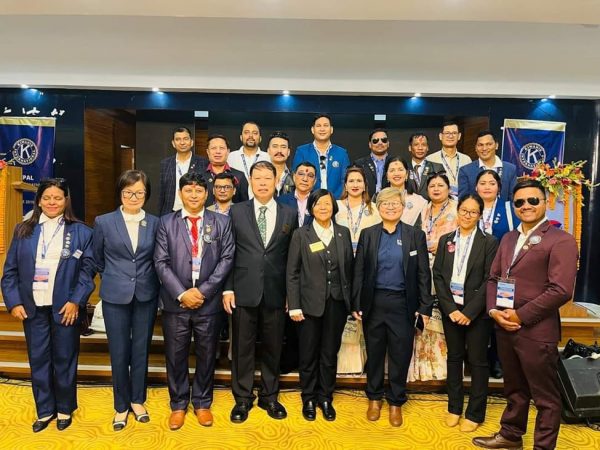
Buddha passed away in Kushinagar, India, in 483 BCE, on the same full moon day of Baisakha, coincidentally the same day as his birth. He achieved Mahaparinirvana at the age of 80. During our visit, we had the chance to see the sacred stone marking Buddha’s birthplace. We also admired the Ashoka Pillar, erected by Emperor Ashoka at the Buddha’s birthplace. This pillar, inscribed in the Pali language, remains a significant historical monument, standing as a symbol of history, religion, and cultural tolerance. We explored the sacred grounds, including the lamps, ponds, and temples. Numerous pilgrims from Nepal, India, and other countries were present.
We all paid our respects at the birthplace of Lord Gautam Buddha, situated in a peaceful and serene location. The Lumbini Development Trust had done an excellent job of managing the site. For convenience, there were proper facilities like restrooms and transportation. I was responsible for managing the logistics of the journey, while Rakesh Basnet was chosen as the accountant. We assigned Nabin Adhikari the task of navigating our route using Google Maps. Narayani and Sushila took on the responsibility of leading patriotic songs throughout the trip.
Following everyone’s suggestion, we continued our journey with a plan to have lunch in Bhairahawa. Mohan Lamsal, the International Treasurer of the Kiwanis Club, kept calling us, sharing his own experiences in the area, which made our trip even more exciting. Similarly, Lt. Governor Bhupal Rawat from Division Five in Dang also called us frequently to inquire about our journey. Anita Pokhrel, Ashish KC, and Hemraj Dangi were also eager to know how our trip was going.
Former Governor Laxman Lamsal, who once resided in the U.S., and Prem Bibash Gharti, a club member currently in the U.K., expressed their regret at not being able to participate in the event. Despite being far away, they stayed in touch, continuously asking where we had reached and how things were going.
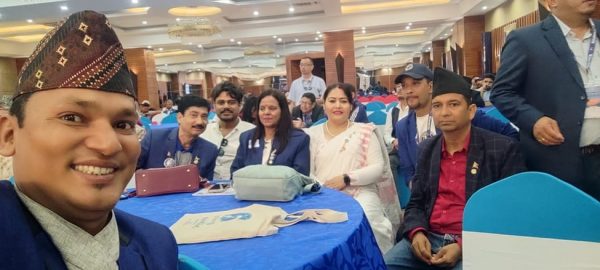
While discussing Gautam Buddha, we had our meal at Barghat. Rakesh Basnet conducted a live broadcast of our journey through the Daunne-Narayanghat road section, using technology to share the experience, as all the team members were curious about that stretch of road. At around 5 PM, we reached Narayanghat, after paying our respects to Nepal’s mighty Narayani River along the way.
Continuing our journey, we reached Hetauda, the capital of Bagmati Province in Makwanpur district, around 7 PM. After asking around for a suitable lodge, we settled on Surya Lodge for the night. The next day, Thursday the 24th, we explored the city of Hetauda and learned about its historical significance before reaching Birgunj, Nepal’s largest trade border, around 10 AM. There, we met with Rajkumar Sindhi, the former central president of the Nepal-India Friendship Association. He graciously took us to Samjhana Hotel, where we enjoyed coffee while discussing Nepal-India relations and Nepal’s industrial trade. We also encountered some friends from Baitadi staying at the same lodge.
From there, we crossed the lush forests of Charkose Jhadi, known as Nepal’s green wealth, and made our way to the new town of Bardibas, finally reaching Bandipur in Siraha. Sushila Shah bought some pineapple there, and they were incredibly delicious. Meanwhile, Narayani Rajoure received a phone call informing her that she had been appointed as the Central Advisor of the Employee Union, which made her so happy that she proposed treating everyone to sweets. We all agreed to stop in Saptari for some famous peda.
After indulging in Saptari’s famous sweets, Rakesh took charge of buying fruits and shrimp at Koshi Barrage. According to Hindu scriptures, the confluence of seven rivers-Saptakoshi-derives its name from the sage Kaushiki. The Saptakoshi River was connected to the eastern highway after the construction of the bridge in 2008 BS (1951 AD). Locals told us that the river has 52 gates, and we had the chance to admire the mighty river. We also had the rare opportunity to see the Koshi Tappu Wetland, the largest bird sanctuary in the world, home to a wide variety of bird species. From there, we finally arrived at our destination, Itahari in Sunsari, at around 6 PM.
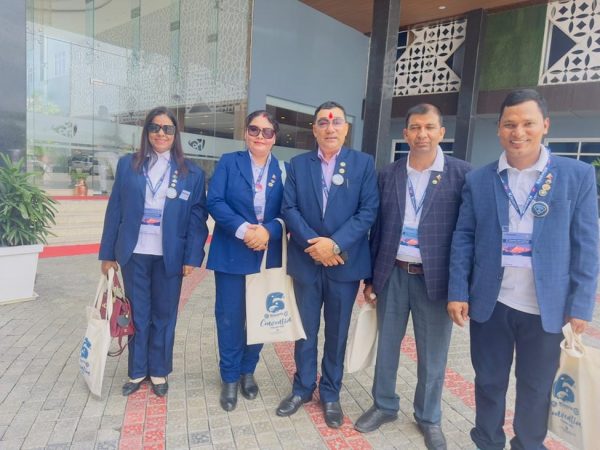
The event organizers had arranged our stay at Tourism Lodge. Upon learning of our arrival, Mamata Tamang, the president of the host club, happily announced our arrival from Dang via a live stream, informing all the club representatives. Since we had journalists in our team, club secretary and journalist Rakesh recorded a short video clip with Mamata Tamang about the event and shared it on social media. The next morning, Friday, after completing our morning rituals, we visited the holy pilgrimage sites of Barahakshetra and Chatara Dham. We also visited Budha Subba Temple in Dharan before returning to Itahari around 11 AM. There, we met up with friends from Dang and other participating clubs.
That day, Bikas Lamsal informed us that he had arranged accommodations for all the representatives from Lumbini Province at City Veranda Lodge, so we also decided to book rooms there. After dropping off our bags, we decided to visit the historic industrial hub of Biratnagar and even crossed into Jogbani in neighboring India for some shopping. Since the event was scheduled for 3 PM, we returned to our lodge around 2 PM and arrived at Solti Hotel, the event venue, promptly at 3 PM.
The host club had already completed our registration and provided us with a bag containing stationery. The opening session of the event was scheduled to begin at 5 PM, with the Chief Minister of Koshi Province, Hikmat Kumar Karki, as the chief guest, along with international representatives from Kiwanis International. Other guests, including former Minister Ram Kumar Subba, were also arriving. The Kiwanis Club had beautifully decorated the gates and the hall, and the event started right on time at 5 PM.
The program began with a welcome song. Following the traditions of the Kiwanis Club, the inauguration took place, and the event moved forward. In this inaugural session, the brothers and sisters from Dang performed patriotic songs and dances. Other artists also entertained the audience with their musical performances. The musical presentations filled the auditorium with energy, and soon everyone, including the guests and participants, joined in, clapping and dancing. It was truly an exhilarating moment. The inaugural session concluded at 9 PM, after which we had dinner and retired to our rooms.
The next morning, we had a leadership selection program scheduled to start at 9 AM. So, early in the morning, we went to meet Koshi Province Chief Parsuram Khapung at his residence in Biratnagar. After reconnecting after many years, he happily spoke about Dang. We had tea and biscuits, took some photos, and then headed to Solti Hotel, where the program was to take place. We arrived at 9 AM and participated in the club’s activities. The candidates were busy meeting with their peers to gather support. Meanwhile, we were occupied with introductions and getting to know other friends. The candidates distributed brochures in their own way.
As the election process moved forward, winning and losing was natural, even though both candidates were capable individuals. According to the club’s constitution, the elected leaders of Kiwanis International Nepal for the year 2024-25 would take charge starting October 1. Krishna Prasad Gyawali had already been selected as the Governor, and Dr. Ram Sharan Thapaliya as the Governor-Elect. The election for the position of Vice Governor took place, and Ram Hari Subedi emerged victorious over his competitor, Shyam Krishna P huyal.
Since we needed to return to Dang, we departed around 5 PM, even before the event concluded. We had planned to stay overnight in Hetauda. Our journey began from Itahari, passing through Chatara Dham, taking the new Madan Bhandari Highway to Hetauda. The stunning hills and mesmerizing natural scenery continued to inspire and guide us with enthusiasm. The team led by Bimal Kumar Paudel, the president of Kiwanis Club of Tulsipur Dang, was also following us. They had planned to stay in Sindhuli that day, while we aimed to reach Hetauda. Despite the dark, foggy weather, our journey pressed on with immense excitement and high spirits. After crossing Gaighat in Udayapur, the rain welcomed us. We continued our journey through the beautiful landscapes of Udayapur and Sindhuli, finally arriving in Hetauda around 11 PM.
Having already booked rooms at Surya Lodge from our previous stay, the lodge management had prepared dinner for us. We ate and spent the night there, ready to start our journey back to Dang at 8 AM the following Sunday morning.
As we continued our journey, we felt the warm breeze of the Terai region, which was accompanied by the swaying leaves. We made a brief stop at Sauraha in Chitwan to enjoy the view, had some fruits, and then resumed our journey. Around 11 AM, we paused for a while at the sacred Narayani River, also known as the Sapta Gandaki, for a brief moment of contemplation. After that, we moved forward and had lunch at Daunne. Following everyone’s suggestion, we planned to head towards Bhairahawa to do some shopping.
We made a few purchases in Bhairahawa, then passed through Lumbini, and stopped for tea and snacks at Chanauta. Sushila bought some bananas during this stop. With the rain pouring down, we were eager to reach home on time. With that thought in mind, we continued our journey. Agreeing to hold a review meeting for the club soon, we finally arrived in Tulsipur, Dang, around 10 PM.
This five-day journey has etched many unforgettable moments in our hearts. We were blessed to visit various religious pilgrimage sites, and this has filled our hearts with joy and fulfillment.
It is worth noting that during the fifth Kiwanis District Convention in Bhairahawa, our Lord Buddha Club had reserved a vehicle and participated extensively. Although that journey was short, it was enjoyable and fruitful. Now, it has been informed that the seventh Kiwanis District Convention will be held in Kathmandu.
Facebook Comment
latest Video
Trending News
- This Week
- This Month





